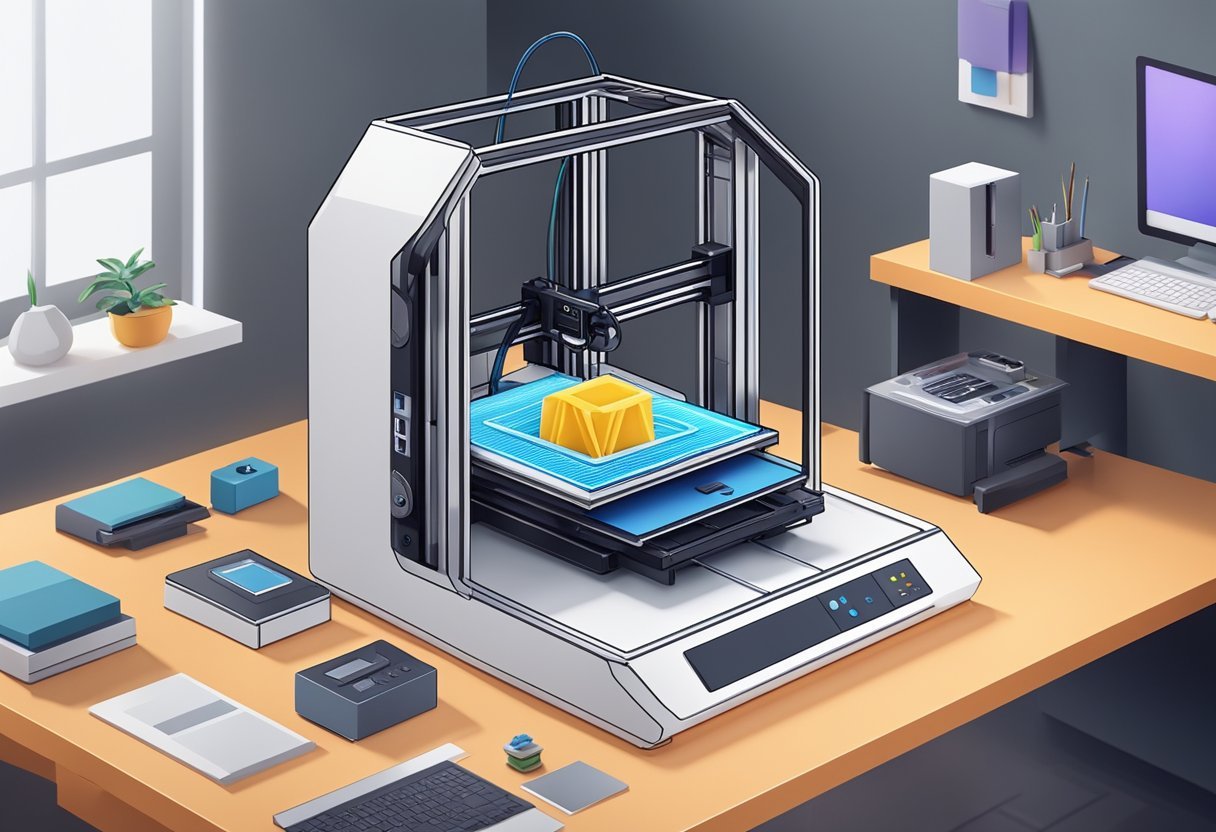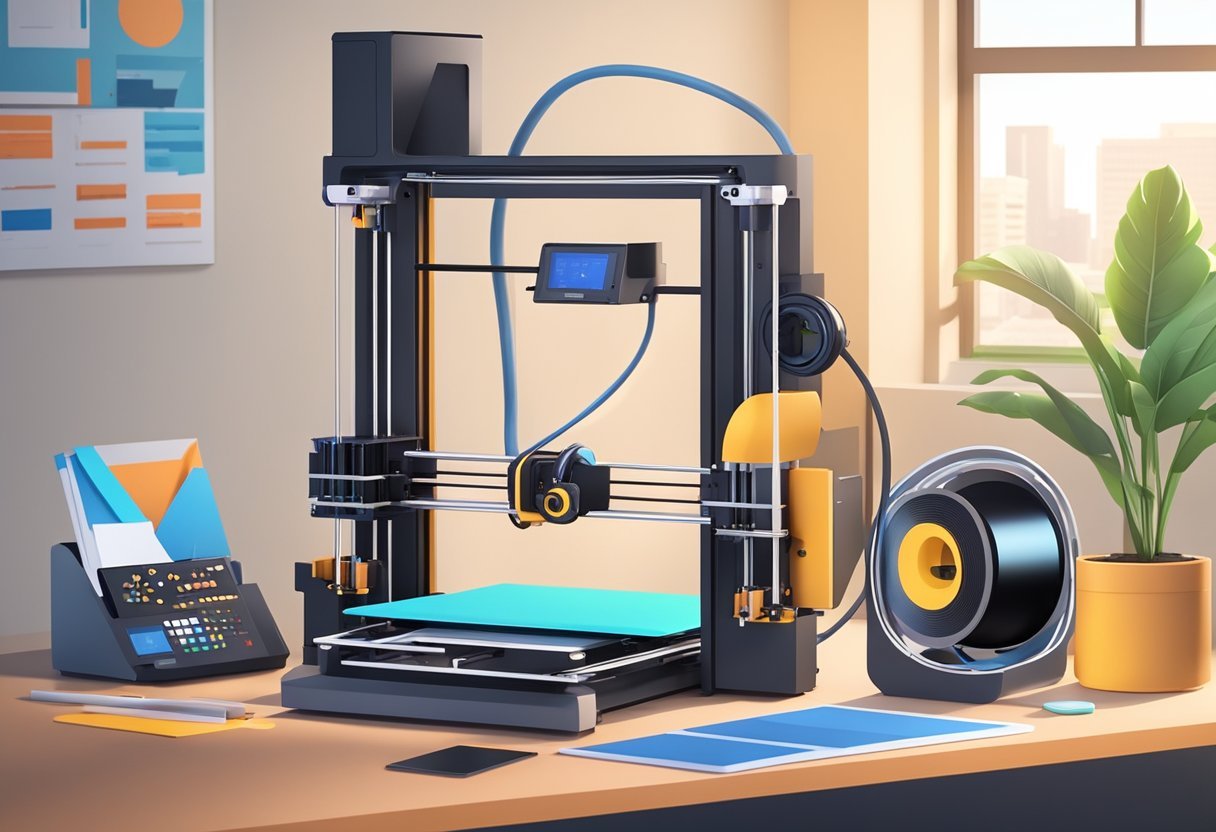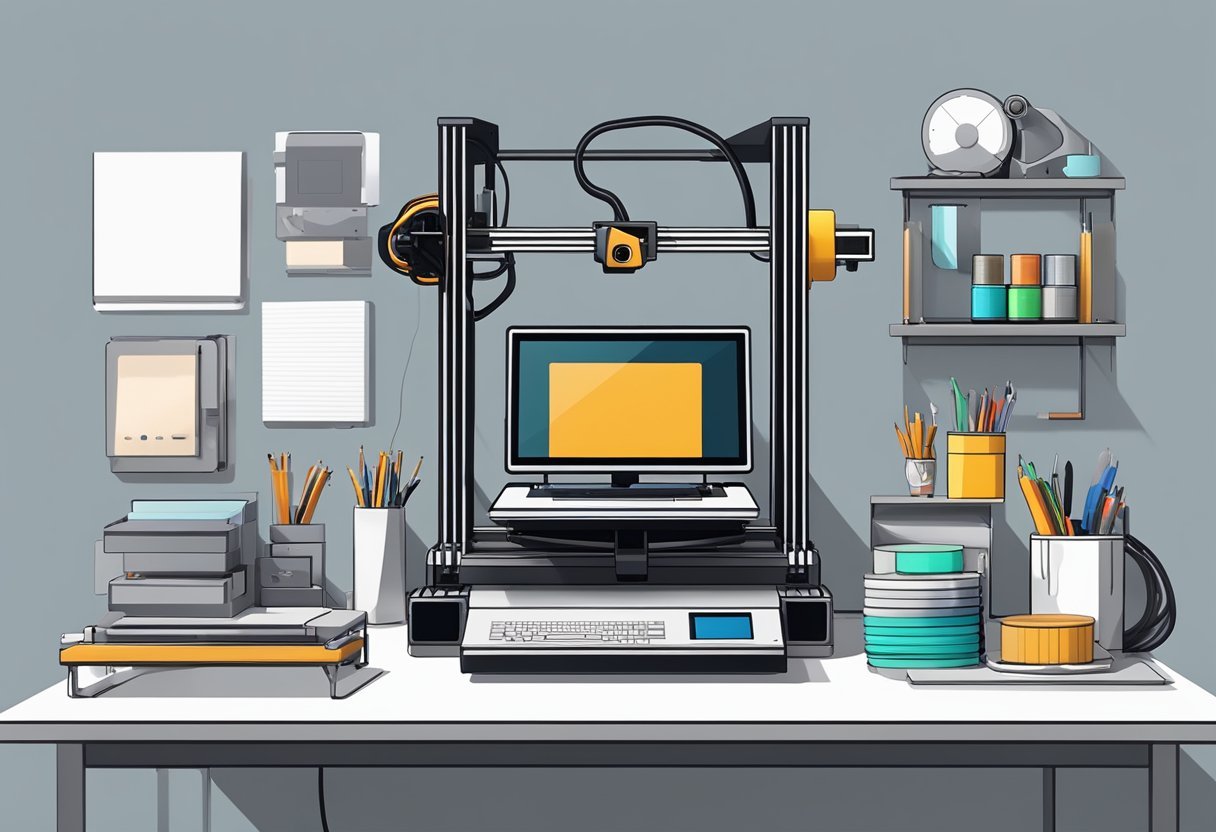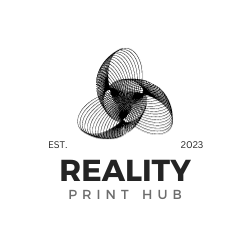3D printing has transformed how we bring ideas to life, converting digital files into tangible, three-dimensional objects. This rapidly evolving technology offers endless possibilities for creative minds and practical users alike. With many resources and designs available, getting started with 3D printing is easier than ever.

For beginners, the first step into 3D printing usually begins with getting acquainted with the required software, slicing tools, and digital 3D models. Once familiar with the fundamentals, individuals can explore practical ideas for home and personal use. The 3D printing community is also a great option for newcomers, presenting open-source designs and a wealth of knowledge to help develop the necessary skills related to 3D printing.
Key Takeaways
- Beginners should understand 3D printing software and slicing tools to create objects.
- Creative projects can be executed at home with various digital files and 3D models available.
- Leverage open-source resources and the 3D printing community to expand your skills and find inspiration for your craft.
Getting Started with 3D Printing for Beginners

Understanding the Basics
3D printing is a powerful technology that allows end users to create objects by adding layers of material on top of one another. This technology offers many use cases, from creating prototypes to producing replacement parts. Before diving into 3D printing, it's important for beginners to understand some fundamental concepts and terminology:
- Filament: The material used by most 3D printers. The most common filament types are PLA (polylactic acid) and ABS (acrylonitrile butadiene styrene). Each has its own properties and uses.
- Extruder: A component of the 3D printer hardware responsible for heating the filament and pushing it through a nozzle, which is then deposited onto the print bed.
- Print bed: The platform where the 3D print is created.
- Slicing: Converting a 3D model into a digital file that contains instructions for the 3D printer.
Choosing Your First 3D Printer
When selecting your first 3D printer, there are a few essential factors to consider:
- Budget: The cost of 3D printers can vary greatly. Be sure to select one that fits within your budget while still providing adequate features.
- Build volume: Consider the maximum size of the objects you plan to print. The build volume indicates the largest object a 3D printer can create.
- Print quality: Assess the printer's ability to produce high-quality prints, which is often measured in terms of layer height and resolution.
- Ease of use: Look for a printer with an intuitive interface and easy setup, as this can help streamline the learning process for beginners.
Some popular 3D printers for beginners include the Creality Ender 3 and the Anycubic Mega-S. These models are known for their reliability, ease of use, and affordability.
With a basic understanding of 3D printing concepts and a suitable printer, beginners can start honing their skills by creating easy 3D print projects. With consistent practice, learning the art of 3D printing is achievable.
Discovering 3D Models and Digital Files

Free STL Files and Where to Find Them
In the realm of 3D printing, STL files are commonly used to represent 3D models. These digital files consist of geometrical information that 3D printers interpret to create physical objects. Thingiverse is one of the most popular platforms with a vast collection of free STL files, which offers many 3D models for various printing projects.
Another useful source for free 3D models is All3DP, which has curated a list of 50 easy and fun things to 3D print. Both beginners and experienced users can benefit from these resources to find interesting and engaging 3D print projects.
Here is a summary of resources to find free STL files:
Creating Your Own Designs
A wide range of user-friendly tools is available for those interested in creating their own 3D models and designs. One such example is Tinkercad, a free web application that allows users to design 3D models in a simple and intuitive manner. With over 50 million users worldwide, Tinkercad has become popular among enthusiasts and educators for introducing 3D design concepts.
Whether you are exploring ready-to-use digital files or designing your 3D models, the world of 3D printing offers plenty of options, tools, and resources to boost your creativity.
Essential 3D Printing Software and Slicing Tools

Selecting the Right CAD Software
Before venturing into the world of 3D printing, the first step is to select the right CAD (Computer-Aided Design) software.CAD software allows users to create digital 3D models, which can later be used for 3D printing. A wide range of CAD software is available, each suited for different skill levels and applications. Some popular options include Autodesk Fusion 360, Tinkercad, and SketchUp.
When choosing CAD software, consider its user-friendliness, compatibility with your 3D printer, and the level of detail required for your 3D models. For those new to 3D modeling, Tinkercad is an excellent choice because it's user-friendly and offers many tutorials to get you started. More experienced users may prefer Autodesk Fusion 360 for its powerful capabilities and extensive range of tools.
Top Slicing Software Programs for Easy Prints
After creating a 3D model using CAD software, end users must convert the model into a format compatible with the selected 3D printer. This is where slicing software comes into play. Slicing software takes your 3D model and "slices" it into layers, generating a set of instructions called G-code for the 3D printer to follow.
Here are some popular slicing software options:
Cura: Developed by Ultimaker, Cura is a free, open-source slicing software with extensive slicing settings. It is ideal for both beginners and experienced users. Cura integrates well with CAD software tools like SolidWorks and Autodesk Inventor, streamlining the 3D printing workflow.
PrusaSlicer: Designed by Prusa Research, PrusaSlicer balances simplicity and advanced capabilities. With a user-friendly interface and support for multiple 3D printer brands, it is a solid choice for any 3D printing enthusiast.
Simplify3D: Although a premium option, Simplify3D boasts unique slicing tools and pre-configured slicing profiles, making it a popular choice for those willing to spend more on top-of-the-line slicing software.
When selecting slicing software, consider compatibility with your printer, ease of use, and the level of customization you need to fine-tune your prints. By selecting the appropriate CAD and slicing software, you'll be well on your way to creating fun and intuitive 3D-printed objects.
Practical Print Ideas for Home and Personal Use
Functional Prints for Everyday Life
3D printing has made creating practical objects for home and personal use easier. There are many cool things about 3D printing that can improve your daily life. Below are a few functional print ideas that you might find helpful.
- Cable organizers: Keep your cables neat and untangled with custom 3D-printed cable holders.
- Custom hooks: Design and print your own hooks for hanging clothes, bags, and accessories.
- Toothpaste squeezer: A 3D-printed toothpaste squeezer can help you extract every last bit of toothpaste from the tube.
- Phone stands: Create personalized phone stands to hold your phone while watching videos or chatting.
- Kitchen gadgets: Print handy tools like custom measuring cups, utensil holders, and bag clips.
Decorative 3D Objects for Home Decor
Not only can you print functional items, but you can also use 3D printing to create unique home decor. Here are some ideas to get you started:
- Vases and planters - Print beautiful vases and planters to hold your flowers or houseplants.
- Lighting fixtures - Design your own lampshades, pendant lights, or wall sconces for a personalized touch.
- Custom shelf brackets - Create stylish and sturdy shelf brackets to match your home's aesthetic.
- Art pieces - Print intricate sculptures, abstract designs, or even 3D versions of your favorite paintings.
- Coasters and trivets - Protect your tabletops with personalized coasters and trivets that complement your home decor.
Combining functional and decorative prints, 3D printing can enhance your home and make your everyday life more enjoyable. With so many printing ideas, you can easily find projects that suit your needs and style.
Executing Your First 3D Printing Project

From Digital File to 3D Object
This process begins with choosing a suitable digital file for your project. Easier, beginner-friendly printing projects can be found on various platforms, such as 30 Easy Projects in 2024 and 3D Printing Ideas for Beginners.
Once you have selected the ideal project, the best part or aspect of 3D printing is transforming your 2D design into a tangible 3D object. To achieve this, appropriate software should be chosen in this next step. TinkerCAD is an excellent option for beginners. It is user-friendly, web-based, and offers a wide range of tutorials.
Before initiating the printing process, check the digital model for errors or inconsistencies, such as non-manifold geometry or intersecting surfaces. Careful inspection will help ensure the success of your first 3D print (step-by-step guide for 3D printing beginners).
Troubleshooting Common Printing Issues
During your 3D printing journey, you may encounter some common challenges that need troubleshooting. Be prepared to tackle these issues to learn and improve your skills.
Here are some common printing issues and their potential resolutions:
Problem: Poor adhesion to the bed surface
- Solution: Adjust the bed leveling, ensure the bed surface is clean, and maintain an optimal temperature.
Problem: Stringing or oozing filament
- Solution: Fine-tune the retraction settings, check the printing temperature, and avoid excessive filament unwinding.
Problem: Over- or under-extrusion
- Solution: Confirm the extrusion multiplier and filament diameter settings, and adjust the extrusion temperature if needed.
Remember, the key to mastering 3D printing lies in consistent practice, experimentation, and resilience. Armed with knowledge and enthusiasm, you will be well-prepared for any challenges that come your way while executing your first 3D printing project.
Creative Projects for 3D Printer Owners

Simple Yet Cool Prints to Make
If you are starting your first 3D printing project and seeking simple yet impressive projects to create, look no further. These projects don't necessarily require advanced skills, but they still produce impressive results. Here are some examples:
Tri Fidget Spinner Toy: This classic fidget spinner toy is fun and easy to print. It can be printed in under an hour, making it perfect for beginners. Check out the design here.
Tokio Bird: A cute little bird figurine that can add some flair to your living space. The Tokyo Bird is a perfect example of a quick and easy 3D printing project.
Fun and Easy Projects for 3D Printing Enthusiasts
For more experienced 3D printing enthusiasts, there are plenty of fun and easy projects that offer creative work and engage the imagination. Be sure to try out these cool ideas:
Snap Cards: Choose from various themes, such as eating utensils, survival cards, a catapult, or even a Star Wars-inspired kit card. These snap cards are sure to excite any 3D printing fan.
Quick Print Designs: Browse Thingiverse's "Quick Print" section for a wide selection of options. Designs such as the Tiny Tester are ideal for quick printing.
Both beginners and experienced 3D printer owners can find many exciting and quick projects to enjoy—and put their creative skills to the test. With a little time and effort, anyone can produce easy yet cool stuff to 3D print and showcase their creativity.
Leveraging Open Source and Community Support
The Role of Open Source in 3D Printing
Open-source projects drive and encourage innovation within the 3D printing community. The RepRap Project is a prime example of how the 3D community comes together to develop advanced, self-replicating machines for creating physical prototypes. Access to such designs and technology has increased the accessibility of 3D printing, making it a reality for individuals, small businesses, and educational institutions.
There are a few noteworthy benefits to utilizing open-source projects in 3D printing:
- Collaborative development: Multiple individuals and organizations contribute to the development of the technology, leading to rapid advancements.
- Lower costs: Open-source technology's do-it-yourself (DIY) nature lowers the barrier of entry for new users.
- Customization: Ability to modify and customize designs based on individual needs.
- Increased trust and transparency: Users can review and audit the source code to ensure quality and security.
Some of the best open-source 3D printer projects include:
- Original Prusa MK4: Prusa Research provides an affordable, high-quality 3D printer supported by a large community of printing enthusiasts.
- LulzBot TAZ: A reliable workhorse printer that is widely used for large-format printing.
- Ultimaker: A popular 3D printing brand that boasts a high-quality printer and software suite.
Open source in 3D printing offers a great way for users to tap into the collective knowledge and experience of the 3D community. At the same time, it helps reduce overall costs and maintains customization options. Through collaboration and knowledge sharing, new projects emerge that benefit the entire industry, driving innovation and enhancing the user experience. The 3D printing community thrives on open-source innovation, leading to a brighter and more advanced future for this emerging technology.
Expanding Your Abilities with Advanced Print Techniques

Mastering Complex Prints
One of the most rewarding aspects of 3D printing is the ability to tackle more complex objects as your skills improve. While 3D printing is known for its relatively low learning curve, mastering advanced techniques will allow you to create models with intricate structures and increased functionality. Incorporating elements such as fasteners, electronics, and sensors can vastly expand the potential applications of your 3D prints.
Some advanced processes worth exploring include:
- Multiple material printing: This printing method creates models that combine different materials with varying properties for strength and flexibility.
- Manifold model creation: Produces watertight structures essential for engineering and architectural applications.
- Inserts and Core modeling: Incorporates non-printed elements, like screws or metal substructures, to enhance functionality while also increasing the durability of the final object.
Learning New Skills with Each Project
Challenging yourself with more advanced 3D printing projects can lead to developing new skills in designing and printing complex objects. The following steps can help guide you in the process:
- Assess your current knowledge: Evaluate your existing skills, the materials you work with, and your familiarity with your printer's capabilities.
- Select a suitable advanced project: Browse through resources like the best 3D printing projects for beginners and choose a complicated design that challenges your current skill level.
- Learn new techniques: Research advanced methods, such as working with higher temperature materials like polycarbonate or TPU, to create more durable and flexible prints.
- Apply your knowledge: Gradually incorporate new techniques into your 3D printing projects, refining your skills with each print.
Remember, practice makes perfect, and as you continue to take on more ambitious projects, you will develop the expertise needed to successfully create complex objects and push the boundaries of your 3D printing capabilities.
Accessorizing Your 3D Printer

Must-Have Add-Ons for Your Printer
Numerous add-ons are available for your 3D printer that can make your life much more convenient. A popular accessory for 3D printers such as Anycubic or Prusa MK models is the Raspberry Pi. Connecting a Raspberry Pi to your 3D printer allows you to remotely control and monitor your printer's progress, greatly enhancing the user experience and saving valuable time.
Another valuable accessory is the 3D pen. 3D pens allow for freehand drawing of objects or designs and are especially useful for touching up prints or creating custom supports. A high-quality 3D pen will improve your workflow, resulting in better prints overall.
Here is a summarized list of add-ons to consider:
- Raspberry Pi
- 3D Pen
- Filament holder
- Spool holder
- Bed leveling sensor
DIY Upgrades for Improved Performance
As a 3D printer user, it is essential to keep upgrading your printer for optimal performance. Some common DIY upgrades for improved performance are:
- Upgraded cooling system: Enhancing the cooling system will improve print quality and reduce warping. Installing a dual-fan setup or upgrading the standard cooling fan can make a significant difference.
Inspirations for Your Next Creation
Unique Objects to Start Off With
3D printing is an innovative and unique way to create functional items and masterpieces from scratch. The possibilities are endless, but when you are just starting, choose simple projects that will help you gradually build your skills. A great example for beginners is a 3D-printed phone stand, which can be customized to suit your taste and style. Other ideas include:
- Desk accessories: pen holders, paperweights, or cable organizers
- Home decorations: vases or customizable wall clocks
- Practical items: measuring cups, trays, or 3D-printed flower pots
Once you're comfortable with basic designs, you can advance to more intricate and intricate projects by experimenting with moving parts or modular systems.
Gift Ideas and Personalized Projects
The beauty of 3D printing lies in its ability to create personalized and one-of-a-kind creations, making it an ideal medium for gift ideas. 3D-printed items, from custom nameplates to unique jewelry pieces, can turn simple ideas into cherished keepsakes.
Here are a few ideas to inspire your personalized projects:
- Jewelry: bracelets, pendants, earrings, or cufflinks
- Toys: personalized figurines, puzzles, or custom board game pieces
- Household items: personalized coasters, kitchen utensils, or soap dishes
Here are some gift suggestions for specific occasions.:
- Birthdays: create a 3D-printed birthday cake topper or unique party favors
- Weddings: design an intricate cake stand or a custom set of champagne flutes
- Holidays: 3D-print festive ornaments, cookie cutters, or snowflake decorations
No matter your experience level, remember to be confident, patient, and curious as you explore the world of 3D printing. Stay open to new ideas and techniques, and don't be afraid to learn from mistakes. Your unique creations will certainly impress and delight, as you continue to master this innovative technology.
Frequently Asked Questions
What are some beginner-friendly projects for 3D printing?
Starting with simple 3D printing projects is a great way to learn the basics. A few beginner-friendly project ideas include keychains, phone stands, and custom nameplates. These projects require minimal design skills and can help users become familiar with their 3D printer's settings and capabilities.
Where can I find free 3D printing projects suitable for students?
Various online platforms, such as Thingiverse, MyMiniFactory, and Cults3D, offer free 3D printing models suitable for students. These websites have extensive libraries of 3D printable files, including educational projects, science models, and art creations that can be tailored to suit students' interests and skill levels.
What cool yet simple items can I 3D print for personal use?
Several cool and simple 3D printing ideas for personal use include pen holders, cable organizers, bookmarks, and toothbrush holders. These items not only make daily life more organized but also allow users to customize designs according to their preferences.
What is the easiest type of filament for a novice to use in 3D printing?
For beginners in 3D printing, PLA (polylactic acid) filament is generally considered the easiest type to work with. This biodegradable thermoplastic is derived from renewable resources like cornstarch, making it an eco-friendly option. PLA requires a lower extrusion temperature than other materials and has great dimensional stability, reducing the chances of printing errors or warping.
Can you recommend easy-to-make 3D-printed items that can be sold?
Some popular, easy-to-make, and potentially profitable 3D-printed items include custom cookie cutters, personalized jewelry and accessories, smartphone cases, and home decor items. These products offer a relatively low production cost while allowing creative customization that appeals to a wide range of consumers.
What are some 3D printing ideas that are perfect for gaming enthusiasts?
Gaming enthusiasts can find numerous 3D printing ideas to enhance their gaming experience or showcase their passion. Examples of 3D-printed gaming items include custom controller stands, dice towers and containers, miniatures for tabletop games, and personalized console accessories.
